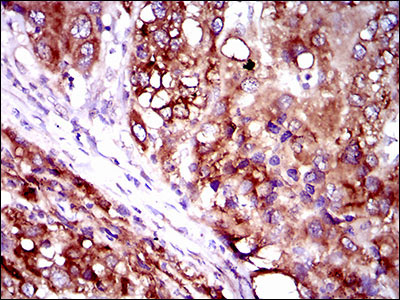SLC27A2 Antibody
Purified Mouse Monoclonal Antibody
- SPECIFICATION
- CITATIONS
- PROTOCOLS
- BACKGROUND

Application
| WB, IHC, E |
|---|---|
| Primary Accession | O14975 |
| Reactivity | Human |
| Host | Mouse |
| Clonality | Monoclonal |
| Clone Names | 6B3A9 |
| Isotype | IgG1 |
| Calculated MW | 70.3kDa |
| Description | The protein encoded by this gene is an isozyme of long-chain fatty-acid-coenzyme A ligase family. Although differing in substrate specificity, subcellular localization, and tissue distribution, all isozymes of this family convert free long-chain fatty acids into fatty acyl-CoA esters, and thereby play a key role in lipid biosynthesis and fatty acid degradation. This isozyme activates long-chain, branched-chain and very-long-chain fatty acids containing 22 or more carbons to their CoA derivatives. It is expressed primarily in liver and kidney, and is present in both endoplasmic reticulum and peroxisomes, but not in mitochondria. Its decreased peroxisomal enzyme activity is in part responsible for the biochemical pathology in X-linked adrenoleukodystrophy. Alternatively spliced transcript variants encoding different isoforms have been found for this gene. |
| Immunogen | Purified recombinant fragment of human SLC27A2 (AA: 346-405) expressed in E. Coli. |
| Formulation | Purified antibody in PBS with 0.05% sodium azide |
| Gene ID | 11001 |
|---|---|
| Other Names | Very long-chain acyl-CoA synthetase, VLACS, VLCS, 6.2.1.-, Fatty acid transport protein 2, FATP-2, Fatty-acid-coenzyme A ligase, very long-chain 1, Long-chain-fatty-acid--CoA ligase, 6.2.1.3, Solute carrier family 27 member 2, THCA-CoA ligase, Very long-chain-fatty-acid-CoA ligase, SLC27A2, ACSVL1, FACVL1, FATP2, VLACS |
| Dilution | E~~1/10000 WB~~1/500 - 1/2000 IHC~~1/200 - 1/1000 |
| Storage | Maintain refrigerated at 2-8°C for up to 6 months. For long term storage store at -20°C in small aliquots to prevent freeze-thaw cycles. |
| Precautions | SLC27A2 Antibody is for research use only and not for use in diagnostic or therapeutic procedures. |
| Name | SLC27A2 |
|---|---|
| Synonyms | ACSVL1, FACVL1, FATP2, VLACS |
| Function | Mediates the import of long-chain fatty acids (LCFA) into the cell by facilitating their transport across cell membranes, playing an important role in hepatic fatty acid uptake (PubMed:20530735, PubMed:22022213, PubMed:24269233, PubMed:10198260, PubMed:10749848, PubMed:11980911). Also functions as an acyl-CoA ligase catalyzing the ATP-dependent formation of fatty acyl-CoA using LCFA and very-long- chain fatty acids (VLCFA) as substrates, which prevents fatty acid efflux from cells and might drive more fatty acid uptake (PubMed:20530735, PubMed:22022213, PubMed:24269233, PubMed:10198260, PubMed:10749848, PubMed:11980911). Plays a pivotal role in regulating available LCFA substrates from exogenous sources in tissues undergoing high levels of beta-oxidation or triglyceride synthesis (PubMed:20530735). Can also activate branched-chain fatty acids such as phytanic acid and pristanic acid (PubMed:10198260). May contribute to the synthesis of sphingosine-1-phosphate (PubMed:24269233). Does not activate C24 bile acids, cholate and chenodeoxycholate (PubMed:11980911). In vitro, activates 3-alpha,7-alpha,12-alpha- trihydroxy-5-beta-cholestanate (THCA), the C27 precursor of cholic acid deriving from the de novo synthesis from cholesterol (PubMed:11980911). However, it is not critical for THCA activation and bile synthesis in vivo (PubMed:20530735). |
| Cellular Location | Endoplasmic reticulum membrane; Multi-pass membrane protein. Peroxisome membrane; Peripheral membrane protein. Cell membrane; Multi-pass membrane protein. Microsome |
| Tissue Location | [Isoform 1]: Expressed in liver, kidney, placenta, intestine, brain, heart, and colon (PubMed:10198260, PubMed:21768100, PubMed:24269233). Predominantly expressed in liver (PubMed:20530735) |

Thousands of laboratories across the world have published research that depended on the performance of antibodies from Abcepta to advance their research. Check out links to articles that cite our products in major peer-reviewed journals, organized by research category.
info@abcepta.com, and receive a free "I Love Antibodies" mug.
Provided below are standard protocols that you may find useful for product applications.
Background
The protein encoded by this gene is a member of the superfamily of ATP-binding cassette (ABC) transporters. ABC proteins transport various molecules across extra- and intra-cellular membranes. ABC genes are divided into seven distinct subfamilies (ABC1, MDR/TAP, MRP, ALD, OABP, GCN20, White). This protein is a member of the MRP subfamily which is involved in multi-drug resistance. The specific function of this protein has not yet been determined; however, this protein may play a role in cellular detoxification as a pump for its substrate, organic anions. Alternative splicing results in multiple splice variants encoding different isoforms. ; ;
References
1. PLoS One. 2011;6(10):e25865. 2. Eur J Cancer. 2011 Feb;47(3):420-7.
If you have used an Abcepta product and would like to share how it has performed, please click on the "Submit Review" button and provide the requested information. Our staff will examine and post your review and contact you if needed.
If you have any additional inquiries please email technical services at tech@abcepta.com.













 Foundational characteristics of cancer include proliferation, angiogenesis, migration, evasion of apoptosis, and cellular immortality. Find key markers for these cellular processes and antibodies to detect them.
Foundational characteristics of cancer include proliferation, angiogenesis, migration, evasion of apoptosis, and cellular immortality. Find key markers for these cellular processes and antibodies to detect them. The SUMOplot™ Analysis Program predicts and scores sumoylation sites in your protein. SUMOylation is a post-translational modification involved in various cellular processes, such as nuclear-cytosolic transport, transcriptional regulation, apoptosis, protein stability, response to stress, and progression through the cell cycle.
The SUMOplot™ Analysis Program predicts and scores sumoylation sites in your protein. SUMOylation is a post-translational modification involved in various cellular processes, such as nuclear-cytosolic transport, transcriptional regulation, apoptosis, protein stability, response to stress, and progression through the cell cycle. The Autophagy Receptor Motif Plotter predicts and scores autophagy receptor binding sites in your protein. Identifying proteins connected to this pathway is critical to understanding the role of autophagy in physiological as well as pathological processes such as development, differentiation, neurodegenerative diseases, stress, infection, and cancer.
The Autophagy Receptor Motif Plotter predicts and scores autophagy receptor binding sites in your protein. Identifying proteins connected to this pathway is critical to understanding the role of autophagy in physiological as well as pathological processes such as development, differentiation, neurodegenerative diseases, stress, infection, and cancer.






